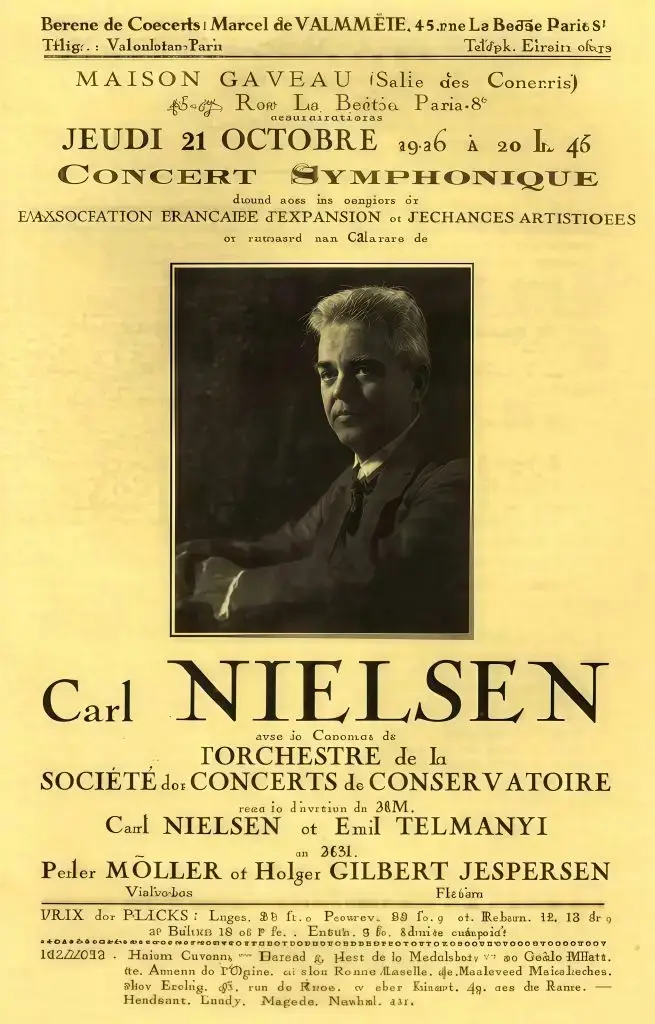
Premiere of Nielsen Flute Concerto on October 21, 1926
Carl Nielsen’s Flute Concerto, composed in 1926, is celebrated for its distinctive blend of modernism and lyrical charm, showcasing intricate dialogues between the solo flute and orchestra within a neoclassical framework.
Origins and Inspirations
Carl Nielsen’s Concerto for Flute and Orchestra, FS 119, was crafted in 1926 specifically for Holger Gilbert-Jespersen, a prominent flautist from the Copenhagen Wind Quintet, following Paul Hagemann. This piece, part of Nielsen’s larger commitment to writing a concerto for each member of the quintet, embodies the vibrant interaction between soloist and ensemble characteristic of Nielsen’s late style. Inspired by the quintet’s performance of Mozart, Nielsen’s engagement with the ensemble led to the creation of his Wind Quintet in 1921, which portrays the musical personalities of its members much like Elgar’s Enigma Variations.
Composition and Premiere
The flute concerto was initiated during Nielsen’s travels in Germany and Italy in August 1926 and was intended to be showcased in Paris at a concert dedicated to his works on October 21, 1926. Due to health issues, Nielsen crafted a temporary ending for the Paris premiere, which was well-received despite its incomplete state. Critics offered mixed reviews, with Paul Le Flem highlighting its “piquancy, drive and humor,” while Jan Meyerheim expressed difficulty in appreciating it. The premiere was a significant event for Nielsen, attended by notable composers Maurice Ravel and Arthur Honegger, who praised the performance.
Musical Structure and Style
The concerto, consisting of two movements instead of the traditional three, showcases Nielsen’s shift towards modernism and a less tonally stable framework, reflective of the 1920s musical trends. It features intricate dialogues between the solo flute and the orchestra, highlighting the flute’s lyrical capabilities against a backdrop of orchestral color.
First Movement: Allegro moderato
The first movement, approximately 11 minutes long, alternates between D minor, E-flat minor, and F major. It includes solo passages for the flute, engaging dialogues with the orchestra, and a notable interruption by the bass trombone, leading to a lyrical cantabile theme in E major. The movement ends with an orchestral cadenza that revisits the opening themes, concluding in a calm resolution.
Second Movement: Allegretto un poco – Adagio ma non troppo – Allegretto – Poco adagio – Tempo di marcia
Described by Nielsen as starting with “a little nastiness,” the second movement opens with playful orchestral notes before the flute enters with “childish innocence.” The movement transitions through variations of tempo from Allegretto to Adagio and concludes with a march-like tempo, culminating in playful slides from the bass trombone.
Legacy and Impact
Completed in January 1927, the concerto has become a staple in the international flute repertoire, celebrated for its unique style and the dynamic interaction between the solo flute and the orchestra. It represents a significant evolution in Nielsen’s compositional style and remains a favorite among flutists for its expressive range and technical challenges.
This event has passed.
Premiere of Nielsen Flute Concerto

